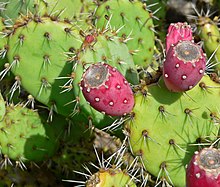Opuntia littoralis
| Opuntia littoralis | |
|---|---|
 |
|
| Scientific classification | |
| Kingdom: | Plantae |
| (unranked): | Angiosperms |
| (unranked): | Eudicots |
| (unranked): | Core eudicots |
| Order: | Caryophyllales |
| Family: | Cactaceae |
| Subfamily: | Opuntioideae |
| Tribe: | Opuntieae |
| Genus: | Opuntia |
| Species: | O. littoralis |
| Binomial name | |
|
Opuntia littoralis (Engelm.) Cockerell |
|
Opuntia littoralis is a species of prickly pear cactus known by the common name coastal pricklypear. It is sometimes called the sprawling prickly pear due to its short stems and habit of growing close to the ground. "Littoral" means "pertaining to the seashore".
Opuntia littoralis is native to southern California and Baja California, where it grows in coastal sage scrub and chaparral habitats. The cactus is variable in appearance; there are several varieties and hybrids with similar species are commonly found.
Opuntia littoralis generally grows in dense clumps spreading several meters wide and up to a meter-3 feet tall. The branches are made up of oval-shaped flat segments up to 22 centimetres (8.7 in) long. It is covered in clusters of yellowish spines 2 to 4 centimetres (0.79 to 1.57 in) long. The flowers are pale yellow or red, occurring in May to June. The fruit is purplish red and up to 5 centimetres (2.0 in) long. The fruit is edible.
...
Wikipedia
